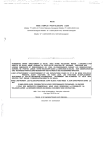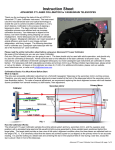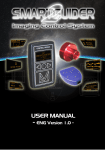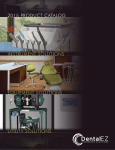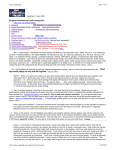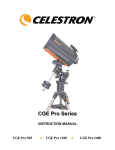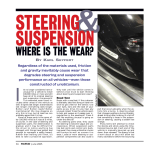Download Orion Schmidt-Cassegrain Telescopes 8", 9.25", & 11" User's Manual
Transcript
INSTRUCTION MANUAL Orion Schmidt-Cassegrain Telescopes 8", 9.25", & 11" ® Customer Support (800)-676-1343 E-mail: [email protected] Corporate Offices (831)-763-7000 Providing Exceptional Consumer Optical Products Since 1975 P.O. Box 1815, Santa Cruz, CA 95061 IN 265 Rev. A 8/05 Congratulations on your purchase of an Orion Schmidt-Cassegrain telescope! The Schmidt-Cassegrain optical system uses a combination of mirrors and lenses and is referred to as a compound or catadioptric telescope. This unique design offers large-diameter optics while maintaining very short tube lengths, making them extremely portable and versatile. The Schmidt-Cassegrain system consists of a zero-power corrector plate, a spherical primary mirror, and a secondary mirror. Once light rays enter the optical system, they travel the length of the optical tube three times, exiting through a hole in the center of the primary mirror to the eyepiece. Orion-brand Schmidt-Cassegrain tube assemblies are made by Celestron International in the U.S.A. The optics feature Starbright® XLT coatings -- enhanced multi-layer coatings on the primary and secondary mirrors for increased reflectivity and a fully coated corrector for the finest anti-reflection characteristics. Unpacking Your Scope Inserting a Star Diagonal Use case when unpacking the shipping carton. We recommend keeping the boxes and all original packaging materials. In the event that the telescope needs to be shipped to another location, or returned for warranty repair, having the proper packaging will ensure that your telescope will survive the journey intact. Returns for refund or exchange will not be accepted without the original packaging. A star diagonal is a prism that diverts the light at a right angle to the light path of the telescope. This allows you to observe in positions that are physically more comfortable than if you looked straight through the scope. Figure 1. Cutaway view of the light path of the Schmidt-Cassegrain optical design. To insert a star diagonal: 1. Turn the set screw on the visual back until its tip no longer extends into (i.e., obstructs) the inner diameter of the visual back. 2. Slide the chrome portion of the star diagonal into the visual back. Attaching the Visual Back The visual back is the accessory that allows you to attach all visual accessories to the telescope. The optical tube should come with the visual back installed. If it is not already on the tube it can be attached as follows: Tighten the set screw on the visual back to hold the star diagonal in place. Finder scope Finder scope bracket 2. Place the knurled slip ring on the visual back over the threads on the rear cell (Fig 2). 3. Hold the visual back with the set screw in a convenient position and rotate the knurled slip ring clockwise until tight. Once this is done, you are ready to attach other accessories, such as a diagonal prism and eyepiece. To remove the visual back, rotate the slip ring counterclockwise until it is free of the rear cell. Focal Length, Ratio Tube Material Coatings 2 Dovetail finder-scope base Visual back 1. Remove the rubber cover on the rear cell. Eyepiece Diagonal Focus knob Figure 2. Rear cell Orion 8" SCT Orion 9.25" SCT Orion 11" SCT 2032mm, f/10 2350mm, f/10 2800mm, f/10 Aluminum Aluminum Aluminum StarBright XLT StarBright XLT StarBright™ XLT ™ ™ Highest Useful Magnification 480x 555x 660x Secondary Mirror Obstruction 2.7" 3.35" 3.75" -- By Area 11% 13% 12% -- By Diameter 34% 36% 34% Tube Length 17" 22" 24" Tube Weight 12 lbs. 20 lbs. 27 lbs. Inserting an Eyepiece Aligning the Finder Scope An eyepiece magnifies the image focused by the telescope. The eyepiece fits into either the visual back directly or the star diagonal. To install an eyepiece: Accurate alignment of the finder scope makes it easy to find objects with the telescope, especially celestial objects. To make aligning the finder as easy as possible, this procedure should be done in the daytime when it is easy to find and identify objects. The finder scope has two perpendicular adjustment screws and a spring-loaded pin that allow easy adjustment of the finder scope horizontally and vertically. To align the finder: 1. Loosen the set screw on the star diagonal until the tip no longer extends into the inner diameter of the eyepiece end of the diagonal. 2. Slide the chrome portion of the eyepiece into the star diagonal. 3. Tighten the set screw on the star diagonal to hold the eyepiece in place. To remove the eyepiece, loosen the setscrew on the star diagonal and slide the eyepiece out. You can replace it with another eyepiece (purchased separately). Eyepieces are commonly referred to by focal length and barrel diameter. The focal length of each eyepiece is printed on the eyepiece barrel. The longer the focal length (i.e., the larger the number) the lower the eyepiece magnification, the shorter the focal length (i.e., the smaller the number) the higher the magnification. Generally, you will use low to moderate powers when viewing. For more information on how to determine power, see the section on “Calculating Magnification.” Attaching a Finder Scope A finder scope is a small, wide-field telescope used to help locate and center objects in the field of your main telescope. The finder scope has a built-in crosshair reticle that shows the optical center of the finder’s field of view. 1. To install an Orion finder scope, you must first attach a dovetail finder scope base (#7215) to the telescope. Line up the through-holes in the base with the threaded holes in the rear cell of the telescope tube. Then insert the two supplied screws through the base and thread them into the telescope holes until secure (Figure 3a). Now you’re ready to attach the finder scope. Figure 3a. Attaching the optional dovetail finder scope base. Focus lock ring Alignment thumbscrews Objective lens Tensioner 2. Unthread the two black nylon thumbscrews until the ends are flush with the inside of the bracket (Figure 3b). Remove the O-ring from the foot of the bracket and slide it over the back of the finder (it will NOT fit over the objective end of the finder). It may need to be stretched a little. Slide it until it seats into the slot in the middle of the finder tube. 3. Slide the eyepiece end (narrow end) of the finder scope into the end of the bracket’s cylinder opposite the alignment screws while pulling the chrome, spring-loaded tensioner pin on the bracket with your fingers (Figure 3c). Push the finder scope through the bracket until the O-ring seats just inside the front opening of the bracket cylinder. Release the tensioner pin and tighten the two black nylon thumbscrews a couple of turns each to secure the finder scope in place. Eyepiece Finder-scope bracket Dovetail foot Figure 3b. The Orion 6x30 finder scope. Figure 3c. Pull the springloaded tensioner outward, then insert the finder scope into the finder scope bracket. 4. Now insert the foot of the finder scope bracket into the dovetail base. Lock the bracket into position by tightening the knurled thumbscrew on the dovetail holder. 3 1 Choose a target that is in excess of one mile away. This eliminates any possible parallax effect between the telescope and finder. 2 Release the altitude and azimuth clamps of your telescope mount and point the telescope at your target. is sharp. Once an image is in focus, turn the knob clockwise to focus on a closer object and counterclockwise for a more distant object. A single turn of the focusing knob moves the primary mirror only slightly. Therefore, it will take many turns (about 30) to go from close focus to infinity. 5. With the image in the finder scope’s field of view, adjust the alignment thumbscrews one at a time to center the object on the intersection of the crosshairs. For astronomical viewing, out-of-focus star images are very diffuse, making them difficult to see. If you turn the focus knob too quickly, you can go right through focus without seeing the image. To avoid this problem, your first astronomical target should be a bright object (like the Moon or a planet) so that the image is visible even when out of focus. Critical focusing is best accomplished when the focusing knob is turned in such a manner that the mirror moves against the pull of gravity. In doing so, any mirror shift is minimized. For astronomical observing, both visually and photographically, this is done by turning the focus knob counterclockwise. Focusing the Finder Scope Image Orientation If, when you look through the finder scope, the images appear somewhat out of focus, you will need to refocus the finder scope for your eyes. The image orientation changes depending on how the eyepiece is inserted into the telescope. When using a star diagonal, the image is right-side-up but reversed from left to right (i.e., mirror image). If inserting an eyepiece directly into the visual back (i.e., without a star diagonal), the image is upsidedown and reversed from left to right (i.e., inverted). This is normal for the Schmidt-Cassegrain design. 3 Center your target in the main optics of the telescope. You may have to move the telescope slightly to center it. 4 Now look in the finder scope. Is the object visible? Ideally it will be somewhere in the field of view. If not, some coarse adjustment to the finder scope bracket’s alignment thumbscrews will be needed until the object comes into the finder scope’s field of view. 1. Loosen the lock ring located behind the objective lens cell on the body of the finder scope (see Figure 3b). 2. Back the lock ring off by a few turns, for now. Refocus the finder scope on a distant object by threading the objective lens cell in or out of the finder scope body. Precise focusing will be achieved by focusing the finder scope on a bright star. 3. Once the image appears sharp, retighten the locking ring behind the objective lens cell. The finder scope’s focus should not need to be adjusted again. Image orientation through the finder scope is upside down. This is normal for any finder that is used straight-through. Because of this, it may take a few minutes to familiarize yourself with the directional change each screw makes on the finder. Focusing the Telescope The Schmidt-Cassegrain focusing mechanism controls the primary mirror, which is mounted on a ring that slides back and forth on the primary baffle tube. The focusing knob, which moves the primary mirror, is on the rear cell of the telescope. To focus, turn the focusing knob until the image is sharp. If the knob will not turn, it has reached the end of its travel on the focusing mechanism. Turn the knob in the opposite direction until the image 4 Normal image orientation as seen with unaided eye. With star diagonal, image in telescope is reversed. With an eyepiece but no diagonal, image in telescope is inverted. Figure 5. Image orientation in Schmidt-Cassegrains Calculating Magnification You can change the magnifying power of your telescope by changing the eyepiece (ocular). To determine the magnification of your telescope, simply divide the focal length of the telescope by the focal length of the eyepiece used. In equation format, the formula looks like this: Telescope Focal Length (mm) = Magnification Eyepiece Focal Length (mm) Figure 4. The emblem on the end of the focus knob shows the correct rotation direction for focusing your telescope. For example, if you are using a 26mm eyepiece in the 8" Schmidt-Cassegrain, divide the focal length of the telescope (2032mm) by the focal length of the eyepiece, 26mm. That yields a magnification of 78. Although the power is variable, each instrument has a limit to how much it can practically achieve. The general rule is 60x magnification per inch of aperture. So an 8"-aperture telescope can achieve a maximum useful magnification of 480 power. This level of magnification assumes you have ideal conditions for viewing, however. The clearest, sharpest views will always be achieved at lower powers. Keep in mind that as you increase magnification, the brightness of the object viewed will decrease; this is an inherent principle of the laws of physics and cannot be avoided. If magnification is doubled, an image appears four times dimmer. If magnification is tripled, image brightness is reduced by a factor of nine! The “F-number” of a telescope stands for the ratio between the focal length and the diameter of the light-gathering element. The 8" Schmidt-Cassegrain optical tube has a focal length of 80 inches and a diameter of 8 inches. This makes the system an f/10 (focal length divided by diameter). An optional focal reducer is available to reduce the effective focal ratio to f/6.3. Determining the Field of View Determining the field of view is important if you want to get an idea of the angular size of the object you are observing. To calculate the actual field of view, divide the apparent field of the eyepiece (supplied by the eyepiece manufacturer) by the magnification. In equation format, the formula looks like this: Apparent Field of Eyepiece You can use a commercially made lens cleaner or mix your own. A good cleaning solution is isopropyl alcohol mixed with distilled water. The solution should be 60% isopropyl alcohol and 40% distilled water. Or, liquid dish soap diluted with water (a couple of drops per one quart of water) can be used. Occasionally, you may experience dew build-up on the corrector plate of your telescope during an observing session. If you want to continue observing, the dew must be removed, either with a hair dryer (on low setting) or by pointing the telescope at the ground until the dew has evaporated. If moisture condenses on the inside of the corrector, remove the accessories from the rear cell of the telescope. Place the telescope in a dust-free environment and point it down. This will remove the moisture from the telescope tube. To minimize the need to clean your telescope, replace all lens covers once you have finished using it. Since the rear cell is NOT sealed, the cover should be placed over the opening when not in use. This will prevent contaminants from entering the optical tube. Internal adjustments and cleaning should be done only by an authorized repair department. If your telescope is in need of internal cleaning, please call Orion for a return authorization number and price quote. = True Field Magnification As you can see, before determining the field of view, you must calculate the magnification. Using the example in the previous section, we can determine the field of view using the same 26mm eyepiece. A 26mm Plössl eyepiece has an apparent field of view of 52°. Divide 52 by the magnification, which is 78. This yields an actual field of 1.5°. To convert degrees to feet at 1,000 yards, which is more useful for terrestrial observing, simply multiply by 52.5. Continuing with our example, multiply the angular field 1.5° by 52.5. This produces a linear field width of 78.8 feet at a distance of 1,000 yards. Care and Cleaning of the Optics Occasionally, dust and/or moisture may build up on the corrector plate of your telescope. Special care should be taken when cleaning any instrument so as not to damage the optics. If dust has built up on the corrector plate, remove it with a brush (made of camel’s hair) or a blower bulb. Then, use an optical cleaning solution and white tissue paper to remove any remaining debris. Apply the solution to the tissue (not to the glass) and then apply the tissue paper to the lens. Low-pressure strokes should go from the center of the corrector to the outer portion. Do NOT rub in circles! Collimation screws Collimation Figure 6. The three collimation screws are located on the front of the secondary mirror housing. The optical performance of your telescope is directly related to its collimation, that is the alignment of its optical system. Your telescope was collimated at the factory after it was completely assembled. However, if the telescope is dropped or jarred severely during transport, it may have to be re-collimated. The only optical element that can be adjusted is the secondary mirror. To check the collimation of your telescope you will need a light source. A bright star near the zenith is ideal since there is a minimal amount of atmospheric distortion. Make sure that tracking is on so that you won’t have to manually track the star. 5 Figure 7. Even though the star pattern appears the same on both sides of focus, it is asymmetric. The dark obstruction is skewed off to the left side of the diffraction pattern indicating poor collimation. Or, if you do not want to power up your telescope, you can use Polaris. Its position relative to the celestial pole moves very little, thus eliminating the need to manually track it. Before you begin the collimation process, be sure that your telescope is in thermal equilibrium with the surroundings. Allow 45 minutes for the telescope to reach equilibrium if you move it between large temperature extremes. Figure 8. In a well-collimated telescope, a defocused star image should appear symmetrical, with the dark central obstruction centered in the star’s ring pattern. Use a medium to high power ocular, something in the range of 12mm to 6mm focal length. It is important to position a star in the center of the field of view to judge collimation. Slowly cross in and out of focus and judge the symmetry of the star. If you see a systematic skewing of the star to one side, then recollimation is needed. Warning: The secondary mirror should never be removed. Adjustments to collimation can easily be made by turning the screws on the secondary mirror mount without ever having to remove the secondary mirror. To accomplish this, you will need to adjust the secondary mirror collimation screw(s) located on the secondary mirror holder (see Figure 6). To make collimation a simple procedure, follow these easy steps: 6. If while turning you notice that the screws get very loose, then simply tighten the other two screws by the same amount. Conversely, if a collimation screw gets too tight, then loosen the other two screws by the same amount. 1. While looking through a medium- to high-power eyepiece, center a bright star in the field of view, then de-focus it until a ring pattern with a dark shadow appears (see Figure 7). Notice in which direction the central shadow is skewed. 7. Once the star image is in the center of the field of view, check to see if the rings are concentric. If the central obstruction is still skewed in the same direction, then continue turning the screw(s) in the same direction. If you find that the ring pattern is skewed in a different direction, then simply repeat steps 2 through 6 as described above for the new direction. 2. Place your finger along the edge of the front cell of the telescope (be careful not to touch the corrector plate), pointing toward the collimation screws. The shadow of your finger should be visible when looking into the eyepiece. Rotate your finger around the tube edge until its shadow is seen closest to the narrowest portion of the rings (i.e., the same direction in which the central shadow is skewed). 3. Locate the collimation screw closest to where your finger is positioned. This will be the collimation screw you will need to adjust first. If your finger is positioned exactly between two of the collimation screws, then you will need to adjust the screw opposite where your finger is located. 4. Use the hand control buttons to move the de-focused star image to the edge of the field of view, in the same direction that the central obstruction of the star image is skewed. 5. While looking through the eyepiece, use an Allen wrench to turn the collimation screw you located in steps 2 and 3. Usually a tenth of a turn is enough to notice a change in collimation. If the star image moves out of the field of view in the direction that the central shadow is skewed, then you are turning the collimation screw the wrong way. Turn the screw in the opposite direction, so that the star image is moving toward the center of the field of view. 6 Perfect collimation will yield a ring pattern that’s symmetrical just inside and outside of focus (Figure 8). Well-collimated optics deliver the optimal performance specifications that your telescope is built to achieve. If “seeing” (i.e., air steadiness) is turbulent, collimation is difficult to judge. If stars are twinkling, that’s a tipoff that the seeing is bad. In that case you might want to wait for a night with better seeing (i.e., when stars aren’t twinkling) to perform the collimation procedure, or you could try pointing the telescope to a part of the sky that appears to have steadier air. Note: Laser collimators will not work with Schmidt-Cassegrains and should not be used in collimating the optics. 7 Orion Two-Year Limited Warranty Orion warrants this telescope to be free from defects in materials and workmanship for two years. Orion will repair or replace such product or part thereof which, upon inspection by Orion, is found to be defective in materials or workmanship. As a condition to the obligation of Orion to repair or replace such product, the product must be returned to Orion together with proof-of-purchase satisfactory to Orion. The Proper Return Authorization Number must be obtained from Orion in advance of return. Call 800676-1343 to receive the number to be displayed on the outside of your shipping container. Items should be sent to Orion Warranty Repair, 89 Hangar Way, Watsonville, CA 95076. This warranty is for the benefit of the original retail purchaser only. All returns must be accompanied by a written statement setting forth the name, address, and daytime telephone number of the owner, together with a brief description of any claimed defects. Parts or product for which replacement is made shall become the property of Celestron. The customer shall be responsible for all costs of transportation and insurance, both to and from Orion, and shall be required to prepay such costs. Orion shall use reasonable efforts to repair or replace any telescope covered by this warranty within thirty days of receipt. In the event repair or replacement shall require more than thirty days, Orion shall notify the customer accordingly. Orion reserves the right to replace any product which has been discontinued from its product line with a new product of comparable value and function. This warranty shall be void and of no force of effect in the event a covered product has been modified in design or function, or subjected to abuse, misuse, mishandling or unauthorized repair. Further, product malfunction or deterioration due to normal wear is not covered by this warranty. ORION DISCLAIMS ANY WARRANTIES, EXPRESS OR IMPLIED, WHETHER OF MERCHANTABILITY OR FITNESS FOR A PARTICULAR USE, EXCEPT AS EXPRESSLY SET FORTH HEREIN. THE SOLE OBLIGATION OF ORION UNDER THIS LIMITED WARRANTY SHALL BE TO REPAIR OR REPLACE THE COVERED PRODUCT, IN ACCORDANCE WITH THE TERMS SET FORTH HEREIN. ORION EXPRESSLY DISCLAIMS ANY LOST PROFITS, GENERAL, SPECIAL, INDIRECT OR CONSEQUENTIAL DAMAGES WHICH MAY RESULT FROM BREACH OF ANY WARRANTY, OR ARISING OUT OF THE USE OR INABILITY TO USE ANY CELESTRON PRODUCT. ANY WARRANTIES WHICH ARE IMPLIED AND WHICH CANNOT BE DISCLAIMED SHALL BE LIMITED IN DURATION TO A TERM OF TWO YEARS FROM THE DATE OF ORIGINAL RETAIL PURCHASE. Some states do not allow the exclusion or limitation of incidental or consequential damages or limitation on how long an implied warranty lasts, so the above limitations and exclusions may not apply to you. This warranty gives you specific legal rights, and you may also have other rights which vary from state to state. Orion reserves the right to modify or discontinue, without prior notice to you, any model or style of telescope. If warranty problems arise, or if you need assistance in using your telescope contact: Orion Telescopes & Binoculars, Customer Service Department, 89 Hangar Way, Watsonville, CA 95076, (800) 676-1343. This warranty supersedes all other product warranties. Orion Telescopes & Binoculars Post Office Box 1815, Santa Cruz, CA 95061 Customer Support Help Line (800)-676-1343 8








